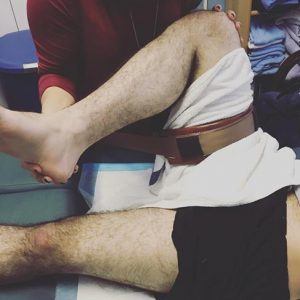
Hip pathology can be a cause of chronic pelvic pain – many patients with pelvic pain and pelvic floor muscle dysfunction have an underlying or related hip disorder. Here is an image of us performing a hip mobilization using a mobilization belt. This technique helps to relax the hip muscles, reduce pain, improve range of motion, reduce joint compression, and stretch the hip. Studies show that a number of patients with chronic pelvic pain have hip impingement syndrome (FAI – femoral acetabular impingement). There are 3 types of FAI. CAM deformity (or camshaft), Pincer, or combined CAM & Pincer. These bone irregularities in your hip can occur on either the femoral head (ball) or the acetabular rim (cup) which can limit motion and put the hip at risk for injury. Hip joint wearing and labral tearing occurs when the extra bone on the femoral head and/or acetabular rim bump against each other in an inefficient biomechanical manner. The labrum is the cartilage that surrounds the rim of the acetabulum. Based on the biomechanical relationship of the hip and pelvis-connecting joints, ligaments, muscles, and nerves the hip disorder can cause pelvic pain symptoms and pelvic floor muscle over-activity on the same side as the hip impingement. We assess, test, and treat for hip dysfunction in all of our patients with pelvic pain. Many patients require surgery yet a good number of patients recover with physical therapy alone. #hipimpingement #pelvicpain #hiprehab #pelvicfloormuscledysfunction #chronicpelvicpain #pelvicfloor #orthopedics #labraltear #physicaltherapy #manualtherapy #expertcare #vulvodynia #prostatitis #sacroiliacjoint #pelvicPT #CPP #CAM #FAI #jointmobilization



